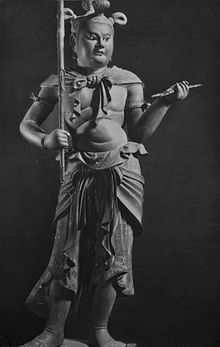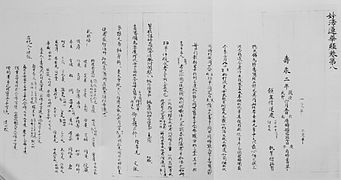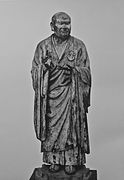Unkei
Unkei ( Japanese 運 慶 ; born around 1140 ; died 1223 ) was an important Japanese sculptor of the late Heian and early Kamakura periods .
Live and act
Unkei was active during the difficult transition from courtly-aristocratic to feudal society, which helped him to break away from older artistic conventions. His year of birth is unknown, but since his son Tankei was born in 1173, it is reasonable to assume that he himself was born in the 1140s.
Unkeis oldest existing work is a Dainichi Nyorai Buddha located in Enjō-ji ( 円 成 寺 ) in Nara from 1176. Although the statue is of the elegance of a Jōchō (d. 1057) that prevailed in the late Heian period, it shows Unkei's talent for fresh and realistic reproduction. In 1183, Unkei copied the Lotus Sutra, the scrolls of which were made from unburnt material from the altar in Tōdai-ji . This work points to his grief over the loss of the Buddha figure when the temple was destroyed in 1180.
1186 Unkei made a sculpture for the Ganjōju-in ( 願 成就 院 ) on Izu for the general and feudal prince Hōjo no Tokimasa ( 北 条 時政 ; 1138-1215 ). Three years later he worked for the resident in the Kantō area warrior Wada no Yoshimori ( 和 田義盛 ; 1147-1213) and created works for the temple Jōraku-ji ( 常 楽 寺 ) in what is now Kanagawa Prefecture . You can study your style on these preserved works, which is based on classical models but is characterized by a new sense of realism and the present. The wild, expressive expression of these figures seems to be due to Unkei's encounter with the warriors of his time.
In 1195, on the occasion of the restoration of the Tōdai-ji, Unkei received the artistic rank of "Hōgen", and in the following years he worked together with his father Kōkei ( 康 慶 ) and his father's students, Jōkaku ( 定 覚 ) and Kaikei ( 快 慶 ), to the four kings of heaven for the temple. Minamoto no Yoritomo and other prominent figures from the Kamakura government supported the project.
After that, Unkei created the Eight Companions of Fudō Myōō for the Kongōbu-ji ( Kōya-san ) in 1197 . Six of them have been preserved and show the now typical Unkei style. In the same and the following year Unkei was busy with the repair of the sanctuary in the teaching hall ( 講堂 , Kōdō ) of the Tō-ji in Kyōto. This happened at the request of Monkaku ( 文 覚 ; 1129–1203), a priest with close ties to Yoritomo. In 1203 Unkei and Kaikei created the two great temple guards ( 仁王 , Niō ) in the Great South Gate of Tōdai-ji. In the same year Unkei received the rank of Hoin.
From 1208 to 1212 Unkei dealt with the replacement of the sculptures in the Hokuen-do of the Kōfuku-ji . Of these, the statue of Maitreya and that of the companions Seshin ( 世 親 ) and Muchaku ( 無 著 ) still exist today . These figures, along with the temple guards in the Great South Gate, best show Unkei's mature style.
There are references to other sculptures for warriors in the Kantō area. Unkei also worked for the court aristocracy in Kyoto, but only as far as they got along with the Bakufu .
In summary, Unkei was associated with the warrior class of the Kamakura period throughout his life. On the basis of the classical sculpture of the Hakuhō, Tempyō and Heian times , he developed his personal style, which corresponded to the taste of the new class. Many of his sculptures are registered as a national treasure. His six sons, Tankei ( 湛 慶 ), Kōun ( 康 雲 ), Kōben ( 康 弁 ), Kōshō ( 康 勝 ), Unga and Unjo continued to work in the style of their father.
photos
Remarks
- ↑ Hōgen ( 法眼 ) is an award for artists, among others, Hōin ( 法 印 ) a higher level.
Individual evidence
- ↑ a b c d Tazawa, Yutaka: Unkei . In: Biographical Dictionary of Japanese Art. Kodansha International, 1981. ISBN 0-87011-488-3 .
literature
- Suzuki, Toshihiko (Ed.): Unkei . In: Nihon daihyakka zensho (Denshibukku-han), Shogakukan, 1996.
| personal data | |
|---|---|
| SURNAME | Unkei |
| ALTERNATIVE NAMES | 運 慶 (Japanese) |
| BRIEF DESCRIPTION | Japanese sculptor |
| DATE OF BIRTH | around 1140 |
| DATE OF DEATH | 1223 |








